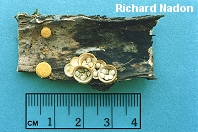 |
| Fig.1 Cluster of Bird's Nest Fungus (Barron, n.d.). |
Name: Crucibulum laeve -Common Bird's Nest Fungus
Family: NidulariaceaeCollection Date: October 8, 2011
Habitat: Growing in mulch
Location: Outside of Hiram College's Gerstacker building in Hiram, Ohio
Description: "The fruiting body is tiny, at first nearly round, becoming cylindrical and then deeply cup-shaped; 5-12 mm high and broad at the top when mature, the rim is more or less circular and covered at first by a hairy lid. Peridium (wall of nest) is one-layered, tough, and persistent. Exterior is vely or shaggy, yellowish or tawny to cinnamon-brown, becoming nearly smooth in age and often darker or whiter. Interior of nest is smooth and somewhat shiny, white, to silvery, gray, or pale cinnamon. The peridioles (eggs) 1-2 mm in diameter, several, whitish to buff or with a very slight brownish tinge, circular but flattened (lens- or disclike), usually attached to nest by long thincords. Widely distributed. Scattered to densely gregarious on sticks, wood chips, nut shells, vegetable debris, humus, and manure" (Arora p. 779, 1986).
Collector: Brooke Warren
Key Used: Arora, D. (1986). Mushrooms Demystified. New York: Ten Speed Press.
Keying Steps:
Key to the Major Groups of Fleshy Fungi
1A. Spores produced on mother cells called basidia; fruiting body variously shaped (see pp. 52-54)... Basidiomycotina, p. 57
Key to the Basidiomycetes
1B. Basidia and spores borne internally (inside the fruiting body or inside a spore case or small capsules); spores not forcibly discharged; thus a spore print is unobtainable... Gasteromycetes, p. 676
Key to the Gasteromycetes
1A. Fruiting body minute (typically less than 15 mm high), consisting of a "nest" (cup, vase, or bowl) containing one or more "eggs" (periodioles); (older specimens, however, may lack peridioles and young ones often have a covering or "lid" pver the top of the "nest")... Nidulariales, p. 778
Key to the Nidulariales
1B. Not as above; fruiting body cylindrical to mug- or cup- shaped when mature, containing more than one "egg" (unless all but one has been expelled)... 2
2B. Not as above; fruiting body typically with a "lid" when very young, the nest usually well formed and persistent; eggs may or may not be imbedded in a mucilage... 4
4B. Eggs white to gray, brown, or black, often (but not always) attached to the side of the nest by a minute cord or short stalk, not imbedded in a mucilage; sides of nest vertical to tapered... 6
6B. Interior of nest smooth or at least not striate or grooved... 7
7A. Eggs typically white to buff; interior of nest not black... Crucibulum laeve (& others)
 |
| Fig. 2 Growing on mulch. Easy to see why it is called the Bird's nest fungus. The Peridium resembles a nest while the Peridioles resemble eggs inside the nest |
| Fig.1 Example of the actual size of this fungus (Kuo, 2003). |
| Fig. 3 Side view of the peridium |
 |
| Fig. 4 View of the fungus as if you were walking by it. As you can see it isgrowing in the mulch in clusters |
 |
| Fig.5 Another example of how small this fungus truly is. If you look closely you can see how capsule hasn't been lost yet (Kuo, 2003). |
Links:
http://www.mushroomexpert.com/crucibulum_laeve.html
http://www.rogersmushrooms.com/gallery/DisplayBlock~bid~5881.asp
Additonal Citations:
Kuo, M. (2003, September). Crucibulum laeve. Retrieved from the MushroomExpert.Com Web site: http://www.mushroomexpert.com/crucibulum_laeve.html
Barron, G. (n.d.). Crucibulum laeve. Retrieved from George Barron's Website on Fungi Website: http://www.uoguelph.ca/~gbarron/GASTEROS/crucibul.htm
Barron, G. (n.d.). Crucibulum laeve. Retrieved from George Barron's Website on Fungi Website: http://www.uoguelph.ca/~gbarron/GASTEROS/crucibul.htm


No comments:
Post a Comment